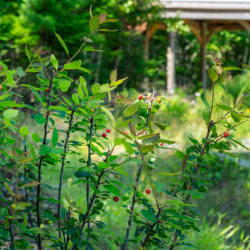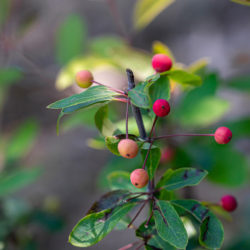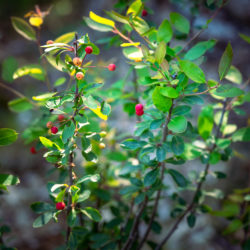Etymology
Ilex is Latin, referring to the holm oak, a Mediterranean evergreen oak; mucronata is Latin, referring to the abrupt tip point on some of the leaves.
Previously known as Nemopanthus mucronatus, this plant has since been determined by genetic testing to be a true holly.
Native Habitat
Wet, peaty or sandy soils, bogs, swamps and wet woodands.
Garden Uses
Pond edges and wet, shaded borders.
Overview
A wetland native, this woody, deciduous shrub graces many of the swamps, bogs, and water edges of the northeastern US, where, unlike its more common relative winterberry, its bright red berries rarely persist into winter. Its flowers and berries each hang on a 1-inch stalk (peduncle). It spreads by root suckers to form erect, multi-branching thickets ranging from 3 to 15 feet in height.
Leaves and Stems
Leaves are typically 1-2 inches in length, 1 inch wide, single, alternate, smooth, and hairless. They can take varied shapes from oblong to obovate (wider at the tip), and may or may not have an abrupt, sharp point (mucronate tip). They grow one leaf per node, each on a leaf-stalk (petiole) that is also hairless, green to purplish, and 1/2 inch long. On new growth tips, leaves can be numerous, appearing to be whorls. The new twig stems are purplish or reddish-brown, smooth, and covered with scattered white lenticels (pores). By the second year, the bark begins to turn grey and flake, gradually aging showing warty horizontal lenticels.
Flowers
Male and female flowers are generally borne on separate plants (dioecious), but some plants will produce both flowers. All flowers are about 1/4 inch in diameter, with 4-5 thin, separated, pale yellow petals that curl up at their tips. Male flowers also have stamens that alternate with the petals and are tipped with yellow, while female flowers have a prominent green ovary with a curly-appearing cap of yellowish-green stigmas. The flowers emerge from the leaf axils of the new year’s growth along with the leaves. Each flower grows on a fine, hairless 1-inch stalk (peduncle).
Fruit/Seed
A round, 1/3-inch, bright red berry is suspended on the 1-inch prior flower stalk. The berry contains several small nutlets, which are scattered by birds and rodents. Rarely do fruits persist long on plants in Maine after ripening due to their favor by birds.
Wildlife Associates
Host plant to caterpillars of the large (3.5 inch wing span) Columbia silk moth (Hyalophora columbia).
Propagation
Seeds require a period of warm stratification followed by cold. Germination can take from 1 – 3 years. Propagate vegetatively by stem tip cuttings.
Ethnobotanical Uses
None found.
Garden Location
Residential Garden, South Woods (see garden map)
Sources
Plant Profile by Kate O'Dell



